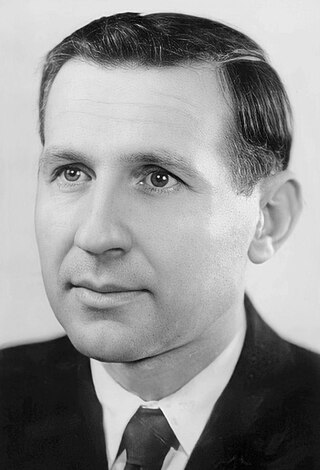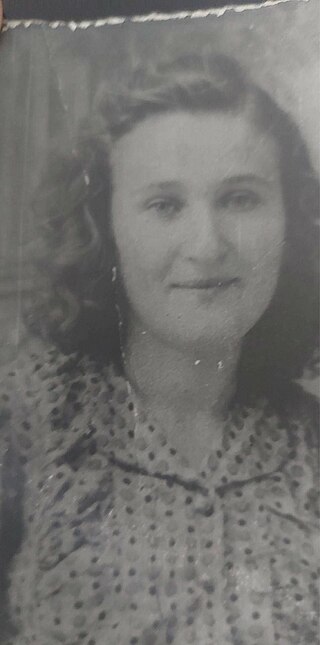
Tirana is the capital and largest city of Albania. It is located in the centre of the country, enclosed by mountains and hills with Dajti rising to the east and a slight valley to the northwest overlooking the Adriatic Sea in the distance. It is among the wettest and sunniest cities in Europe, with 2,544 hours of sun per year.

In Albania, World War II began with its invasion by Italy in April 1939. Fascist Italy set up Albania as its protectorate or puppet state. The resistance was largely carried out by Communist groups against the Italian and then German occupation in Albania. At first independent, the Communist groups united in the beginning of 1942, which ultimately led to the successful liberation of the country in 1944.

Mehmet Ismail Shehu was an Albanian communist politician who served as the 23rd Prime Minister of Albania from 1954 to 1981.
The Balli Kombëtar was an Albanian nationalist, collaborationist, and anti-communist resistance movement during the Second World War. It was led by Ali Këlcyra and by Midhat Frashëri. The movement was formed by members from the landowning elite, liberal nationalists opposed to communism, and other sectors of society in Albania.

Haxhi Lleshi was an Albanian military leader and communist politician who served as the Chairman of the Presidium of the People's Assembly of the People's Socialist Republic of Albania from 1953 to 1982.
The Antonio Gramsci Battalion was formed on 9 November 1943 from captured Italian soldiers who wished to continue the war by resisting Nazi German forces in Albania. In the beginning its forces amounted to 137 men who chose their own leaders: Terzilio Cardinali (commander), Alfredo d'Angelo, Giuseppe Monti and Dominico Bogatai. One Albanian partisan, Sami Kotherja, was also appointed to battalion command. The battalion was composed of two companies.

The Armed Forces Academy (AFA) is a military education institution which trains military officers in Albania.
Vithkuq is a village and a former municipality in the Korçë County, southeastern Albania. At the 2015 local government reform it became a subdivision of the municipality Korçë. The population at the 2011 census was 1,519. The municipal unit consists of the villages Vithkuq, Leshnje, Gjanc, Lubonjë, Rehovë, Roshanj, Trebickë, Grabockë, Treskë, Stratobërdh, Panarit, Shtyllë and Cemericë.
The Chameria battalion was a battalion of the National Anti-Fascist Liberation Army of Albania during the Second World War. It was formed from the organized resistance groups of Cham Albanians on 15 June 1943 and was renamed as the IV Chameria Group in October 1943, which ceased to exist after the Liberation of Albania. It included at the time of its creation more than 500 armed troops, the vast majority of whom were Albanians from the Greek part of Chameria region and the rest from the Albanian part, and about 40 members of the Greek minority in Albania.

The National Liberation Movement, also translated as National Liberation Front, was an Albanian communist resistance organization that fought in World War II. It was created on 16 September 1942, in a conference held in Pezë, a village near Tirana, and was led by Enver Hoxha. Apart from the figures which had the majority in the General Council it also included known nationalists like Myslim Peza. In May 1944, the Albanian National Liberation Front was transformed into the government of Albania and its leaders became government members, and in August 1945, it was replaced by the Democratic Front.

Beqir Balluku was an Albanian politician, military leader, and Minister of Defense of Albania. Balluku assisted Enver Hoxha in carrying out the 1956 purge within the Party of Labour. However, in 1974, Balluku himself, along with a group of other government members was accused by Hoxha of an attempted coup d'état against the Albanian People's Republic. He was executed the next year.

The Albanian People's Army was the national army of the People's Socialist Republic of Albania from 1946 to 1990. Like the militaries of other Communist states, the UPSh was subjected to the nation's ruling party, in this case the Party of Labour of Albania. In fact, as in other Communist states, the Party considered the military to be a creation of the Party itself. The UPSh consisted of the Ground Forces, the Navy and the Air Force. The militia of the UPSh was the Voluntary Forces of Popular Self-Defense (FVVP), and affiliate military structures included the Armed School Youth (RSHA) and Civil Defense of the Republic (MCR). After the fall of communism in Albania, the UPSh was replaced by the Albanian Armed Forces.
The House of Taushani was an Albanian aristocratic family prominent from the 15th to 19th century. According to prof. Stavri Naci, the most powerful families of Albania that played an important economic and political role were, "in Shkoder, the Bushati and Caushollaj; in Peja, Begollaj; in Elbasan, Taushani and Bicaku; in Vlora, Velabishtaj and Vlora; in Delvina, Kapllanpashalli; in Kruja, Toptani; and in Kavaja, the Alltuni."
Haki Toska was an Albanian politician of the Albanian Party of Labour (PPSh).

Kadri Hazbiu was an Albanian politician of the Albanian Party of Labour (PPSh).

Xhafer Spahiu was an Albanian politician of the Albanian Party of Labour (PPSh). He was the only Kosovar Albanian of the higher ranks of the Communist Albania leadership after 1948.
The Congress of Përmet, was a meeting of the Albanian communist leaders on May 24, 1944, in Përmet, Albania, which elected a Provisional Government. The congress was modeled after the Anti-Fascist Council for the National Liberation of Yugoslavia. 188 delegates attended the Congress. The majority of the delegates came from Southern and Central Albania: 25 from Korça, 48 from Vlora-Gjirokastra, 15 from Berat, 8 from Elbasan, 10 from Tirana, 3 from Peza, 2 from Durrës. Additionally, the congress was attended by delegates of the National Liberation Movement and the Brigades.

Liri Gero (1926–1944) was a young Albanian communist activist and resistance member during World War II. Fighting along the partisan forces, she was killed in a skirmish with the Nazis. For her heroism she received the title People's Hero of Albania.

Sofia Noti (1925–1944) was an Albanian World War II freedom fighter and a national martyr. A nurse, she was captured as a POW, and then hanged by the Nazi forces in the concentration camp Pavlou Mela, in Thessaloniki, Greece.

Thoma Koço Xhixho was a major-general of the Albanian Army, military scientist, founder and first commander of the Albanian Military Academy. He is one of the framers of the Albanian Military Art, as well as the base documents and regulations for training in the Albanian Army. During World War II, Thoma Xhixho was one of the important leaders of the National Liberation Army (NLA). At the onset of the Antifascist Resistance in Albania, he was one of its first members and one of the first commanders of the armed resistance against occupation forces.













